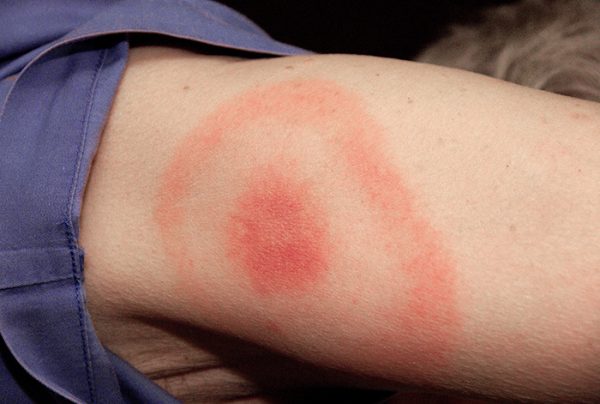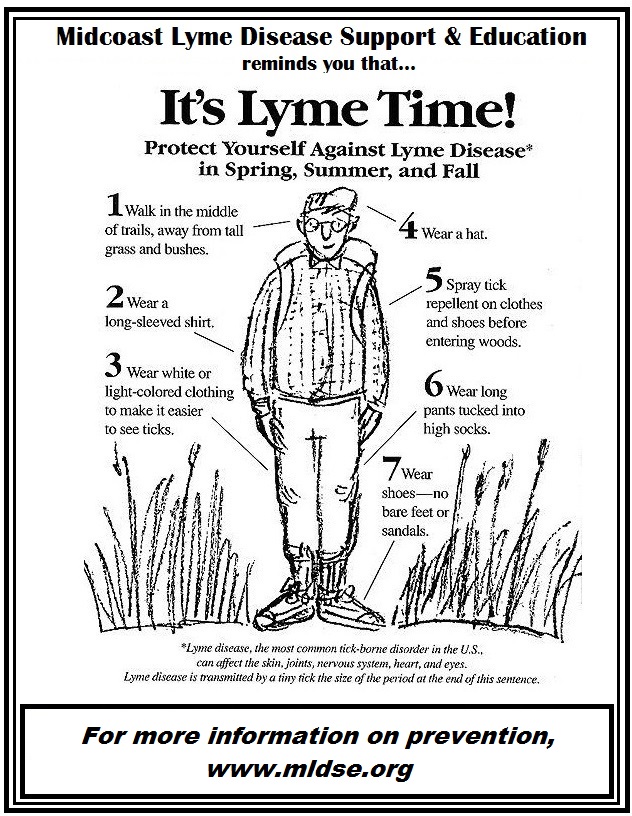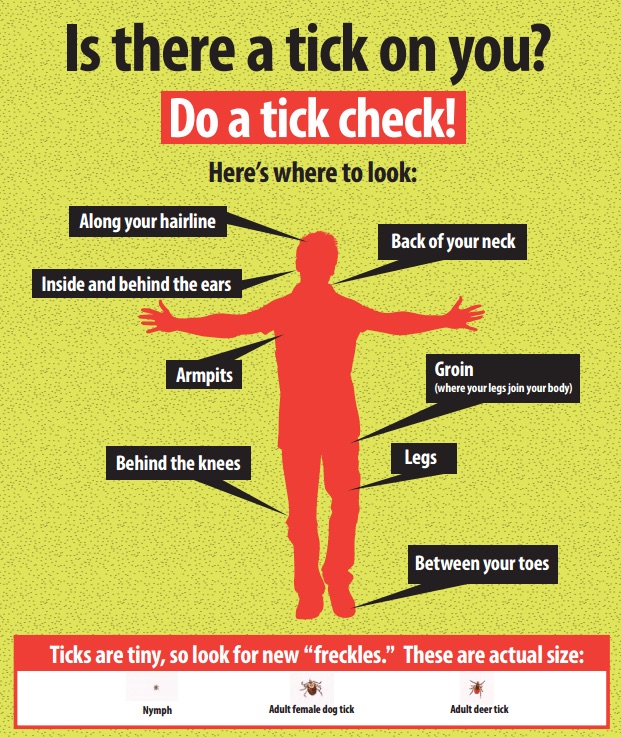
Summer in New England is such a wonderful time to do all sorts of outdoor activities. But the threat of ticks and the illnesses they can carry prevents some people from enjoying themselves. That threat is real and it has hit close to home.
Lyme Disease hits close to home
In the past year, our family has seen four cases of Lyme Disease. My husband got it two separate times. The first was last fall. He had no rash, only an unexplained fever and some aches and pains. His intuition sent him to the doctor’s office and, once he got back a positive blood test, he was treated with a course of the antibiotic doxycycline.
The first person I contacted for advice was Paula Jackson Jones. More about that wonderful woman in a moment. She said to make sure they tested for co-infections, which he had to ask for. They all came back negative, thank goodness. He was prescribed two weeks of doxycycline, but Paula recommended four and the doctor agreed.
I have talked to and written about so many people who have suffered the consequences of not being diagnosed or treated appropriately. Sometimes it’s because the person never found a tick, never got a rash, or had flu-like symptoms but didn’t think of Lyme Disease. Other times, people have sought medical help and even then, a tick-borne illness wasn’t considered.
My best advice is if you live in an area where there are ticks and you have the slightest nagging feeling that you might have been infected, don’t brush it off (that was NOT intended as a pun). And please, don’t be afraid to ask questions or to be assertive.
I am so grateful my husband followed his intuition. After about a week he had no more symptoms … until a few weeks ago when he woke up early one morning with a stiff neck and sore joints and muscles. He thought it was because he’d spent the entire previous day painting and doing several other projects around the house. He was really bummed because he was convinced it was his age catching up with him.
I noticed a big red oval on his left scapula. We both thought it was a pressure mark because of the way he’d slept. Two days later, I noticed that it was still there. Not a bulls-eye, but it looked like the center of the rash in this picture, only much larger.
Off he went to Maine Medical Center Urgent Care Plus, where he was quickly diagnosed with a brand new case of Lyme Disease. Yes, you can be re-infected. Because it’s a bacterial infection, not a virus, the antibodies that your body produces will not protect you against getting the disease again if you are bitten by another infected tick. He was automatically given a 28-day prescription for doxycycline and will have a followup blood test this week.
The third case was in another relative, who, sadly, at the same time, developed an itchy browntail moth caterpillar rash on her upper body. Then she noticed a strange rash on her leg that didn’t seem to be connected. Off to the doctor’s office she went, where she was diagnosed with Lyme Disease. We are fortunate that all of these cases were diagnosed early and hopefully, there will be no lingering effects.
The fourth case was in our cat, Charlotte — the same kitty who almost lost her life a while back after swallowing a thread. Charlotte had a couple of seizures, but no cause could be found.
Lyme Disease is uncommon in cats, especially indoor cats like Charlotte, but because the vet had seen seizures in cats a few times and it turned out they had Lyme Disease, she ordered a blood test, and you guessed it, it came back positive. She, too, had a course of doxycycline.
It’s been several months and she seems to be ok, no seizures that we’ve witnessed. Fingers crossed big time. Maybe she got infected by a tick that we inadvertently carried into the house or maybe it was from a little mouse she caught. And I felt sorry for the mouse!
Protecting against tick-borne illnesses
Now, about Paula Jackson Jones. Sometimes, it’s very confusing to figure out exactly what we should try to do to protect ourselves and our kids and our pets. In this guest post, Paula, who has become an expert on the subject, tries to set us straight on steps we can take.
Unfortunately, she had her own encounter with a tick and not only developed Lyme disease but several other tick-borne illnesses. It took 18 months to get a diagnosis and three years of treatment before she went into remission.
In 2014, Paula co-founded Midcoast Lyme Disease Support & Education (MLDSE) with Angele Rice. Angele was diagnosed with Lyme Disease and two other tick-borne illnesses 17 years after she was bitten by a tick as a child. She has had ongoing treatment for the past nine years. You can read Paula and Angele’s stories on the MLDSE website.
When their paths crossed, they realized that through their own arduous journies, they had both accumulated a wealth of knowledge. They decided to create their organization to “raise awareness, foster education, advocate for change and provide support for those affected by Lyme Disease and other tick-borne associated diseases.”
In addition to the information and resources on their website, they also host an annual Lyme Disease conference that brings in experts from around the country. Paula also has a newspaper column and writes a blog called Lyme Time. This guest post pulls information from her blog.
What about repellents?
Skin, clothing, pets, home, and yard are all important areas to focus on as these are areas ticks come into contact with us. What you choose to put on your skin is a personal preference. Whether it’s Deet, Picaridin, essential oils or other natural repellent balms and salves, there is no wrong answer. But some products are safer than others (for children and pets) so carefully consider before purchasing.
Wearing white clothing and tucking your shirt into pants, pants into socks does not repel ticks, it only makes them easier to find. You want to repel and you have options!
Permethrin, a product derived from the chrysanthemum plant that kills ticks on contact, is FDA approved in over 1400 products and used by the military on their uniforms and gear. You can purchase this at the local hardware store and do it yourself or, for those with health or environmental concerns, you can purchase clothing already infused with a heavy concentration such as tops, pants, vests, socks, hats, gloves and blankets. You can also send your clothing to have it infused with a heavier concentrated application (email me for more information).
Visitors, did you know that you can connect with a local vet and have your pet protected while you’re here on vacation? Local vets can connect with your vet back home and get an instant health history and be able to prescribe the best product based on the age, breed and overall health condition of your pet.
Cleaning cabins and cottages with products containing Lemongrass and Eucalyptus creates a safe and natural deterrent for ticks. There are also safe and natural products to use on the outside such as Diatomaceous Earth to repel ticks. For higher infested areas, consider contacting a service provider who uses organic repellent sprays. Remember, we want our visitors to enjoy their stay tick-free!
Note from Diane: Mainely Ticks in Wells, Maine is a good resource.
DO YOUR TICK CHECKS!
Always check for ticks when you come in from spending time outdoors.
- Look over your body top to bottom for nymph and adult ticks that you may have unknowingly brought inside with you.
- Ticks crawl from the ground up looking for the perfect place to feed upon and they thrive in moist, dark areas.
- The best way to do a tick check is to remove your clothing, toss in the dryer on high heat for 10 minutes and then check the following areas:
- Under the arms, in/around the ears, inside the belly button, back of the knees, in your hair, between the legs/groin area, and around your waistline.
- Nymph ticks are no larger than a poppy seed and are often missed. Use a mirror for hard to see places.
- You can also shower using products containing rosemary, eucalyptus and tea tree oil that repels and washes out any ticks you may have missed while checking your hair (Remember: tea tree oil is not safe for pets).
What to do if you find a tick
If you have a tick encounter, save the tick and have it tested so that you will know for certain if/what you have been exposed to.
By using prevention practices and doing daily tick checks, you are taking charge and reducing your chances of being exposed to a tick ~ and can enjoy outdoor life in Maine as it should it be!
If you’d like more information about ticks, Lyme Disease, and other tick-borne infections, be sure to check out Midcoast Lyme Disease Support & Education.






I was looking through my Feedly news feed and saw a picture I reconginized. Looks like a nice place to stay.
And will get the chance to visit this summer?
Going to try…
Are there ticks in your neck of the woods?!